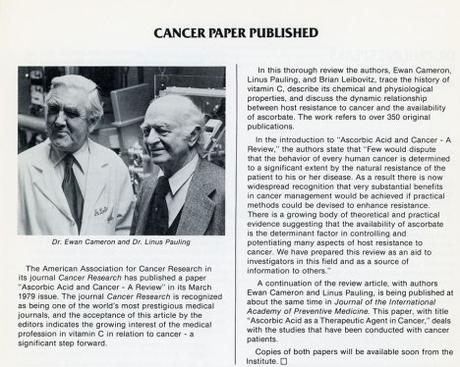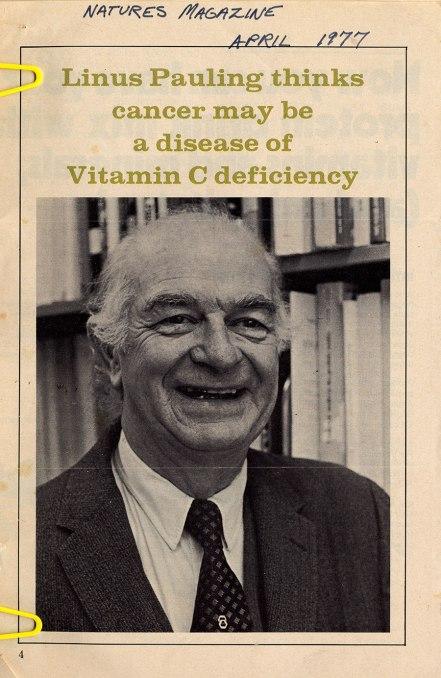
Announcement published in the LPISM Newsletter, Spring 1979.
[An examination of “Ascorbic Acid and Cancer: A Review,” published in 1979. This is part 2 of 2.]
Linus Pauling and Ewan Cameron began their paper “Ascorbic Acid and Cancer: A Review” – published with Brian Leibovitz in Cancer Research in March 1979 – by detailing the history of research on ascorbate and establishing a connection between cancer and scurvy. This line of thinking was predicated on the observation that cancer patients, like scurvy patients, were abnormally deficient in Vitamin C. The authors, in turn, traced this observation back to the importance of Vitamin C in maintaining the balance of the intercellular matrix. They likewise emphasized that cancer is a disease that originates in the body, emanating from the patient’s own cells.
The paper next identified the two main traits of cancer: abnormal cell proliferation and invasiveness. Keeping these characteristics in mind, the authors hypothesized that the release of an enzyme, hyaluronidase, contributed to occurrences of cancer. Hyaluronidase breaks down the gel-like substance that surrounds cells, they argued, and creates a pathway that allows cells of any kind to continue multiplying. In healthy individuals, this process is self-limiting. When the process goes completely unchecked however, cells can become malignant and invade the surrounding tissue. Pauling and Cameron believed this to be the likely mechanism for metastasis, the point in a cancer’s progression at which survival rates plummet.
While they knew that it was highly unlikely that a simple infusion of Vitamin C would cure a cancer patient – as it would do in the case of scurvy – Pauling and Cameron theorized that an infusion of this sort would contribute to the inhibition of hyaluronidase, thus keeping cell proliferation in check. As they repeatedly emphasized in their review, Vitamin C’s main benefit was to increase host resistance to diseases that caused unrestrained cell proliferation. What Vitamin C did not do was guarantee complete remission.
Once they had described ascorbic acid’s defensive role, the authors moved on to its limited ability to take the offensive. One function that increased Vitamin C was believed to carry out was the capacity to “encapsulate” a tumor or disseminated tumors to the point where they were no longer malignant. As Pauling pointed out to his colleagues, when his wife Ava Helen was first diagnosed with stomach cancer and surgeons went in to remove her tumor, they noted that the mass had unusual presentation for its location and appeared to be encapsulated. Ava Helen had been taking large doses of Vitamin C for several years before she was first diagnosed, and her husband attributed the nature of her tumor and the ease of its removal to her intake of Vitamin C.
Central to the review paper were the clinical results that Ewan Cameron had compiled at the Vale of Levin Hospital in Alexandria, Scotland. Cameron had begun to see positive results early on, but found that his studies were somewhat skewed because so many of his patients were terminal and ended up dying regardless of their treatment. Cameron was worried that his data did not present much of an argument in favor of Vitamin C, a situation that was further muddied by the fact that, “the terminal stages of cancer are a compound of so many human, individual, pathological and even emotional variables, as to be nearly impossible to quantify.”
In an effort to provide what the authors believed to be a more accurate picture of Vitamin C’s treatment benefits, Cameron’s later studies measured survival time in ascorbic acid patients and compared them with non-ascorbic acid patients. This comparison revealed that a patient on supplemental ascorbic acid survived, on average, four times as long as a patient with a similar prognosis who had not received ascorbic acid.
In conducting his trials, Cameron encountered the additional barrier of patients who failed to adhere to the Vitamin C regimen once they were released from the hospital. Cameron called this mode of behavior the “reverse placebo” effect, noting that some patients, when left to their own devices, would discontinue their ascorbic acid intake because it was “just Vitamin C.” Believing that it would be treated with greater respect if it sounded more like a drug, Cameron half-jokingly suggested that pharmacies rename Vitamin C as “Pauleron” to dissuade patients from underestimating its potential.

In the final section of their review paper, Pauling and Cameron warned of unexpected and unexplained potential consequences associated with ascorbic acid therapy. In particular, some of Cameron’s patients, after showing marked improvement for several weeks or even months, succumbed to what Pauling called a “whirlwind” of cancer. Autopsies later revealed sudden massive tumor growth and dissemination.
Interestingly, most of these “whirlwind” tumors contained a large volume of necrotic cancer cells. Pauling put forth two possible explanations for this, which he included in the review. One explanation was that, though necrotic cancer cells can be less harmful than live cancer cells, the inflammation caused by their presence might cause rapid tumor growth or become toxic to the patient in such a large volume.
A second explanation, which he thought more plausible, was based on the understanding that abruptly discontinuing Vitamin C caused ascorbate levels to plummet. In this circumstance, if ascorbic acid was inhibiting tumor growth as believed, a drastic and sudden decrease in the treatment could lead to rapid, unrestrained tumor growth.
Pauling couldn’t provide solid evidence for either possibility, but he felt that both supported the review’s hypothesis. In the first instance, ascorbic acid could be killing the cancer cells. In the second, the negative consequences of withdrawing ascorbic acid inversely suggested the benefit of continued ascorbic acid use.
Pauling and Cameron concluded their review by listing areas of ascorbate research that were encouraging but had, to date, only received preliminary investigation. Specifically, the paper pointed out that no trials had been conducted to consider the effects of ascorbate in general cancer management.
The Cameron, Pauling and Leibovitz review provoked mixed reactions. Many readers, particularly aspiring physicians, were intrigued and encouraged by the results. On the other hand, quite a few others remained skeptical and focused on the aspects of treatment that Vitamin C could not promise to provide. Shortly after the review came out, Pauling received a letter from a medical student who reported that the paper had been torn out of archived copies of Cancer Research at both Cornell Medical College and the Sloan-Kettering Cancer Center. Pauling confirmed that this had happened at both locations, but was unable to persuade anyone to rectify the situation.
In the fall of 1979, a handful of months after the review was published, the Mayo Clinic released the results of its own clinical trial, which concluded that Vitamin C did not contribute to longer survival times, nor did it offer any therapeutic benefit for cancer patients. When the results were published in the New England Journal of Medicine, Cameron wrote a letter to the editor providing a rebuttal of sorts.
In Cameron’s letter, he pointed out that the Mayo Clinic hadn’t followed the same procedures as those used at the Vale of Leven. Importantly, in Cameron’s trial, only 5% of patients had received recent chemotherapy treatment. By contrast, in the Mayo Clinic trial, only 5% of patients hadn’t received recent chemotherapy. Cameron also suggested that patients, fearful that they were in the control group and not receiving supplemental ascorbate, were dosing themselves with Vitamin C, as it was easy to obtain outside of the trial setting. If this was indeed the case, the Mayo Clinic data likely supported the Cameron-Pauling hypothesis.
Despite Cameron’s centrality to the debate, the editor of the New England journal refused to print his letter, a decision that only increased the levels of skepticism surrounding Cameron and Pauling’s work.

In publishing their review and the papers that led up to it, Pauling and Cameron sought to update the popular view of cancer as an invasion of foreign cells that needed to be entirely destroyed to produce clinical success. Once people accepted a new view of cancer, Pauling believed that attitudes toward cancer treatment would also change.
Perhaps most importantly, Pauling and Cameron wanted physicians to stop assuming that troubling side effects were a sign of a treatment’s success and instead to begin concentrating more on the overall health of patients. Though they focused primarily on Vitamin C, the duo hoped that their review would encourage researchers to gather more evidence for an orthomolecular approach to cancer, one that would emphasize vitamins and natural methods as opposed to cytotoxic chemicals.
Although Pauling and Cameron’s perspective was not widely accepted during their lifetimes, researchers today are increasingly focusing on alternatives to chemotherapy and radiation. Immunotherapy, still in its infancy during Pauling’s life, has now become a standard treatment for certain cancers. Additionally, researchers have been able to show that high-dose Vitamin C, administered intravenously at even higher levels than Pauling and Cameron had attempted, does indeed provide therapeutic benefits in some cancers.
Advertisements &b; &b;